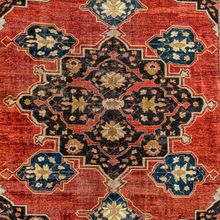Arak Rug
| Arak Rug | |
|---|---|
 Design of Arak Rug (Rugman) | |
| General information | |
| Name | Arak Rug |
| Original name | قالی اراک |
| Alternative name(s) | Arak Carpet (Sultan Abad) |
| Origin | |
| Category | City |
| Technical information | |
| Common designs | Herati (Fish), Lachak Toranj |
| Common colors | Crimson, Red, Navy Blue, Green, Cream, Beige, Blue |
| Dyeing method | Natural, Synthetic |
| Pile material | Wool, Silk |
| Foundation material | Cotton |
| Knot type | Asymmetrical (Persian) |
Arak Rugs originate from Arak, previously known as Sultanabad, is the capital city in the Province of Markazi, located in west central Iran. A very important region in the making of Persian area rugs, the roots of its commercial rug weaving industry can be traced back to the 17th century. After World War II the Province of Arak became known for a particular style of rug called the Sarouk. These very attractive area rugs, named after a village in the area, typically feature detached floral sprays in an all-over design on a red background. Arak rugs are woven using asymmetrical Persian knots. The quality of the rug is largely dependant on the number of knots per square inch and may vary from rug to rug.
History
Arak, formerly Sultanabad, is a city in west central Iran. Today Arak is the capital city of Markazi Province. In this province are several important towns and villages that made carpets and rugs beginning in the mid-nineteenth century, some of which have achieved recognition in the carpet industry worldwide, such as FARAHAN, LILIHAN, MOHAJERAN, MOSHKABAD, SAROUK, and SULTANABAD, among many others.[1]
In accordance with the neighboring cities like Qum, Kashan and Isfahan carpet production history, it’s logical to consider the same history for Arak carpet production. It is said in history books that when Shapur II (an ancient emperor of Persia) was crossing the region, he was offered with a carpet. Founders of the new city called for Industries and specialists of different arts and crafts. There are reasons to say many designers and weavers from Kerman, Isfahan, and Kashan came to the new Arak.
The city being built on commercial roads, once to protect them was now a fresh opportunity for businessmen. In 1874, some traders from Tabriz were the first to export some carpets from the region. Two years later in 1876, the Swiss Ziegler company founded an office in the city, Followed by many other foreign companies like New York Tawshandchian, East company, Levan Davoodian company and many others. Most of these companies had dyeing places of their own. In 1924 a nationalization took place in Iran Carpet Industry and the business was since ran by The Iran Carpet Company.
Existing Carpets of those times are mainly named Sarouk, Farahan and Arak. Before the foreign companies arrival perhaps there were many designs and colors, but according to Scissile Edwards, During 1939 to 1942, only three major patterns were accepted, Mushk Abad, Sarouk, and Mahal.[2]
By the late twentieth century many Arak Province weavers made carpets similar to those from other provincial cities and villages in accordance with the der foreign and domestic consumers.[3]
Great designers of Arak were Isa Bahadori, Asadollah Dahighi, Abdolkarim Rafiei, Asadollah Ghaffari, Hosein and Hasan Tehrani, Jafar Chagani, Zabihollah Abtahi, Asadollah Abtahi, Seyed Hajagha Eshghi (Golbaz), Ezzatollah Ebrahimi, Mohamad Bagheri, Parwiz Minaii, Gholamreza Baderestani and Haj Reza Saiidi.[4]
Materials
Foundation and Pile
Silk pile and silk foundations were frequently used in antique pieces, but rarely seen in new Arak rugs. In general the foundation is cotton, but on occasion goat hair is used. The wool of the area rugs is hand spun, usually from the weaver's own sheep.
Techniques and structures
Color and dyeing
Arak carpets were famous for two colors, Sarough Dooghi Farahan blue and Mushk-Abad Runasi. In addition to those dominant colors, green, crème and straw yellow colors were used. Using runas (rarely red grains), vine leaf, pomegranates peel and walnut peel were common practices.[5] Arak rugs are predominantly red and navy blue, while green and ivory are prominently used as well.
Motifs and Designs
In the 1920s weavers in this region transitioned away from their traditional designs to those more attuned to the American market.[6]
Arak rugs usually feature one of three major patterns. The most well known is the Herati, featuring small fish throughout the field, with or without a central medallion. The Sarough is a more curvilinear pattern of intertwined grapevines throughout the field and a round central medallion. The pattern known as Wiss is comprised of three diamonds that make up the central medallion.
Weaving techniques
Arak rugs are woven using asymmetrical Persian knots.
The Arak carpet has Persian knots, and is hand woven. Looms are vertical and the warps are fixed on the loom on the ground. Previously double wefts were used but single thick wefts are now common.
Although 15-20 raj carpets are among the humble, low standard carpets, MushkAbad carpets gain international fame due to their fine dyeing, motifs and good quality wool. This is also seen in better quality carpets (SarouK) of that time with 35-40 and 45 Rajs. SarouKs are woven in Farahan.[7]
See also
Ferahan Rug, Lilihan Rug, Mohajeran Rug, MoshkAbad Rug, Sarouk Rug, Sultanabad Rug
References
Bibliography
- Abraham Levi Moheban, (2015), The Encyclopedia of Antique Carpets: Twenty-Five Centuries of Weaving, NewYork: Princeton Architectural Press.
- Nazmiyal Antique Rugs, (2019).
- Ehsan Afzalzadeh Naini, (2005), Arak Carpets, JOZAN: Rug news and antique rugs.
- JOZAN: Rug news and antique rugs.